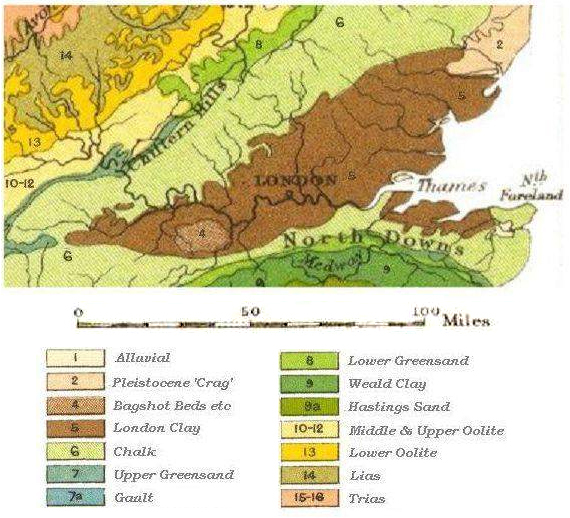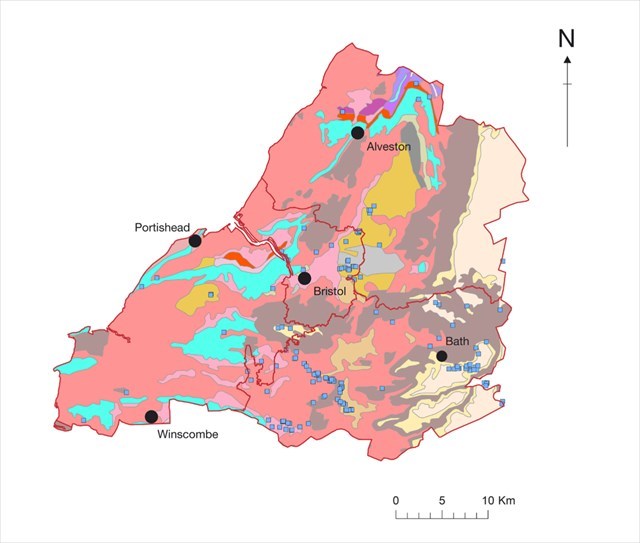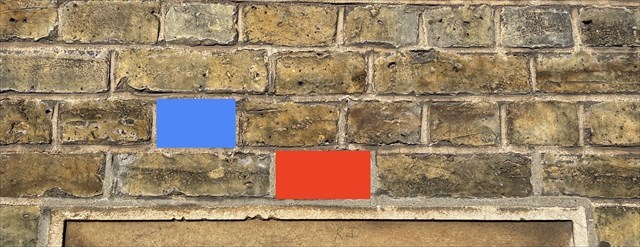This simple EarthCache contrasts London stock bricks and Bath stone as building materials.
London Stock Bricks

The rock below London dates from the late Cretaceous period (100-60 mya) but is overlain by sedimentary layers from the early Paleogene period (59-46 mya). These are mainly sands, clays and gravels deposited in a shallow sub-tropical marine environment when the London Basin was formed. These layers vary in depth from 60m to 320m. One of them is London Clay, indicated in dark brown on the map above. It runs from Wiltshire (where it is only 5 m deep) to Essex and North Kent (where it lies up to 150 m deep). A grey-blue material that turns pale brown when exposed to air, London clay is easily deformable owing to its high water content and the tiny size (1-4 micrometres) of its component mineral particles. These are hydrous aluminium phyllosilicates (smectite, illite and kaolinite, with smaller quantities of chlorite) which settled out of slow-moving water onto the Paleogene sea bed but were not sufficiently compressed to become mudstone.
In its upper layers, London Clay contains thin deposits of brickearth, a type of loess where the clay forms a mixture with sand (mostly rock and mineral) and silt (mostly quartz). Accessible, highly compressable and easily worked, brickearth can also be hardened at a lower temperature than pure clay. With traditional London stock bricks, sifted ash and cinders are mixed with the clay, a technique which adds a built-in fuel and considerably reduces the cost of production. However, this process gives rise to pock marks, cavities and clinker spots left behind by the burning ash. Differences in mineral composition also produces variations in colour that range from greys and yellows, to orange, pink, red and even maroon stocks. Reddish or maroon bricks are made from upper strata of brickearth, low in lime and rich in iron oxides. Yellow and grey stocks are made from the more abundant, slightly calcareous, clay found in the lower strata, where iron oxides are less prevalent.
Although stock bricks are highly porous, thanks chiefly to the practice of including ash in the clay mixture, they also harden with age. These characteristics make them more resistant to weathering than the decorative sedimentary facing stones with which they are often paired by architects. Pure yellow handmade bricks, with their characteristic coal pitting, are regarded as classic London stocks. Those with with pink, red and grey tones are usually referred to as multis.
Bath Stone

Map Source : British Geological Survey © NERC
Bath stone is found in the southern section of the Cotswold Edge, a large outcrop of sedimentary rock laid down in several stages during the Jurassic period (200-145 mya). It is a bioclastic oolitic limestone of the Great Oolite Group, indicated by the beige areas on the right edge of the map above. Bath stone was formed on the sea bed during the Bathonian stage of the middle Jurassic period (168-166 mya) when the climate of Southern England was sub-tropical. As dissolved carbon dioxide (CO2) was released through the effect of warming by the sun, positively and negatively charged ions of calcium and bicarbonate in the supersaturated seawater bonded to form a precipitate of calcium carbonate (CaCO3) known as calcite. The calcite crystals coated minute particles of sand and organic material, over time forming tiny balls (oolites). The spherical oolites settled into the sediment, becoming buried and gradually cemented into limestone by the deposition of more calcite. When quarried, Bath stone is typically buff or pearly white, although it weathers to a golden honey colour over time owing to the presence of ferruginous compounds in the rock matrix.
Once exposed to the elements, all building materials are subject to weathering. There are three main types of weathering: physical (chiefly freeze-thaw or exfoliation), chemical (typically dissolution, hydrolysis or oxidation) and biological (caused by living organisms, most often plants). Limestone is particularly susceptible to chemical weathering, because the dissolved CO2 in rainwater reacts easily with the CaCO3 in its structure.
St John the Divine was built in 1829-31, one of many so-called Commissioners' Churches erected in England between 1819 and 1840. It is an early design by Lewis Vulliamy (1791-1871), a lesser known Gothic Revivalist architect whose most famous work is probably Westonbirt House in Gloucestershire. The nave and west end of the church are constructed in an elaborate Italianate style, with pinnacles, flying buttresses and a miniature steeple, all somewhat out of keeping with its small scale. By the end of the 1800s, the church congregation had embraced Anglo-Catholicism and decided to extend the original building to the east to accommodate a more ceremonial form of worship. In 1905, a chancel and Lady Chapel were added to an imposing Arts and Crafts design by local architect and choir member Arthur Grove (1870-1929). The church is Grade II listed and constructed using London stock bricks with Bath stone dressings.
To log the EarthCache, you now need to answer three questions.

Q1. Using the above photo as a guide, examine the two half-bricks indicated in the wall by the blue and red rectangles. Describe the bricks here in terms of the colours that you see. Thinking about the clay used, what do you think has caused the colour variations in each brick?
Q2. Look at the foundation stone below. Compare the upper left corner area and the bottom right corner area of the stone. Describe each part of the stone in terms of surface composition, colour and uniformity. What has caused the differences between the two areas?
Q3. Compare the two building materials, brick and stone. Which is more resistant to weathering, and why?
Please email or message me your answers using the link to my profile at the top of the cache page. A photo of you at GZ is welcome, but optional, and please do not include pictures that give clues for any of the questions. You may log the find as soon as you have sent me your answers but if it is obvious that you have not visited the church then your log will be deleted.
****************** ********************
For full information on how you can expand the Church Micro series by sadexploration please read the Place your own Church Micro page before you contact him at churchmicro.co.uk
See also the Church Micro Statistics and Home pages for further information about the series.
****************** *******************